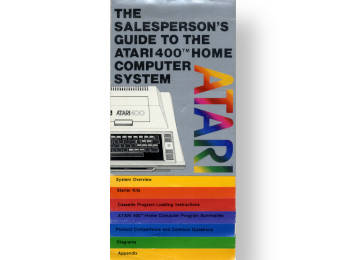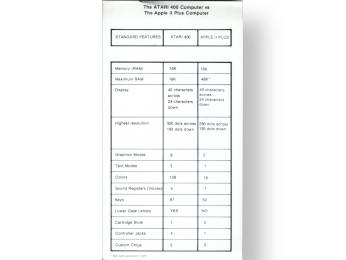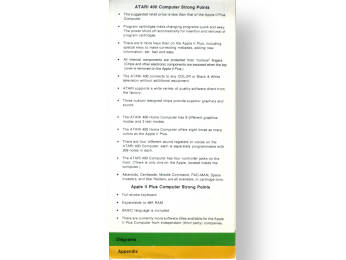The salesperson's guide to the Atari 400 home computer system
In July 1982, Atari offered its dealers a small booklet entitled "The salesperson's guide to the Atari 400 home computer system". An equivalent brochure, entitled "The Atari 800 Home computer system salesperson's guide", was also distributed for the Atari 800.
The aim of this booklet for the 400 was multiple:
- To present the 400 model and its peripherals
- To explain where to plug in all these cables and how to "make it work", to demonstrate it for an audience
- To introduce some classic software and some "all-in-one" kits
- To provide arguments (for forthcoming heated discussions with potential clients) to compare the 400 with the competitors of the time
At the time of writing this booklet, Atari identified the following computers as plausible competitors of the Atari 400:
- Apple II Plus
- Commodore Vic-20
- Tandy TRS-80
- Texas Instruments TI 99/4A
- Mattel Intellivision (with/without keyboard)
It is strange and almost comical — in retrospect — to realise that Atari seemed genuinely concerned about a gaming console, the Mattel Intellivision, and its upcoming keyboard expansion. The availability of this keyboard became a joke, a running gag in the industry and even within Mattel. According to Wikipedia, the Mattel Intellivision keyboard component debacle was ranked as No. 11 on GameSpy's "25 dumbest moments in gaming".
Historical context
Note that at this very moment, in July 1982:
- Atari did not yet offer the 48K expansion for the Atari 400 (Really?)
- Atari did not brag about offering 256 colours{1} but 128. Is it because only the latest produced models are equipped with GTIA{2}?
According to the magazine "The Atari connection" (volume 2, number 2, summer 1982)", page 5-6-7: - The Commodore 64 was about to be released (August 1982)
- The Atari 5200 game console was not yet released (November 1982)
- The Apple IIe was not yet released (January 1983)
- The Atari 1200XL was not yet released
Wikipedia: - Texas Instruments had not yet thrown in the towel, before dropping out in March 1984.
Wikipedia: - AtariSoft did not yet offer to its direct competitors those games (Centipede, Pac-Man, etc.) that the brochure reproaches them for not offering in their catalogue. It was considered a definite advantage for Atari to have them
[...] Originally installed in all Atari 400 and 800 shipped to Europe, the GTIA made use of Europe's higher resolution TV screens.
Now being installed in all US models, the new chip has been praised widely [...]
Announced at a New York City press conference on December 13, 1982; presented at the Winter Consumer Electronics Show (CES) on January 6-9, 1983; shipped in March 1983.
The TI 99/4A became the first in a series of home computers to be orphaned by their manufacturer over the next few years.
{1} Please read the "256 Colours" article in the knowledge base for all the details.
{2} Please read the "CTIA/GTIA" article in the knowledge base for all the details.
Comparison table, part #1
| Standard feature | Atari 400 | Apple II+ | Commodore VIC-20 | Tandy TRS-80 color | Texas Instruments TI 99/4A |
|---|---|---|---|---|---|
| Memory (RAM) | 16K | 16K | 5K | 16K | 16K |
| Maximum RAM | 16K | 48K {3} | 32K | 32K | 52K |
| Display (text) | 40 x 24 | 40 x 24 | 22 x 23 | 32 x 16 | 32 x 24 |
| Highest resolution | 320 x 192 | 280 x 192 | 176 x 184 | 64 x 32 | 256 x 192 |
| Graphics modes | 9 | 2 | 1 | 1 | 2 |
| Text modes | 3 | 1 | 1 | 1 | 2 |
| Colors | 128 {4} | 16 | 16 | 8 | 16 |
| Sound registers (voices) | 4 | 1 | 4 | 1 | 3 |
| Keys (keyboard) | 61 | 52 | 66 | 53 | 48 |
| Lower case letters | Yes | No | Yes | No | Yes |
| Cartridge slots | 1 | 0 | 1 | 1 | 1 |
| Controller jacks | 4 | 1 | 1 | 2 | 1 |
| Custom chips | 3 | 0 | 1 | 0 | 1 |
{3} [This footnote appears in the original brochure] 64K with accessory card.
{4} 128 colours with CTIA, 256 colours with GTIA and its 3 additional graphic modes.
Comparison table, part #2
| Standard feature | Atari 400 | Intellivision without keyboard | Intellivision with keyboard |
|---|---|---|---|
| User-Programmable | Yes | No | Yes |
| Programmable memory | 16K | None | 16K |
| Maximum programmable memory | 16K | None | {5} |
| Display (text) | 40 x 24 | n/a | 39 x 24 |
| Highest resolution | 320 x 192 | 160 x 192 | 160 x 192 |
| Graphics modes | 9 | 1 | 1 |
| Text modes | 3 | 0 | 1 |
| Colors | 128 {6} | 16 | 16 |
| Sound registers (voices) | 4 | 3 | 3 |
| Keys (keyboard) | 61 | 0 | 60 |
| Lower case letters | Yes | No | Yes |
| Cartridge slots | 1 | 1 | 1 |
| Controller jacks | 4 | 2 controllers built-in | 2 controllers built-in |
| Custom chips | 3 | 0 | 0 |
{5} [This footnote appears in the original brochure] As of this printing (July 1982), the manufacturer has not specified the method or availability of equipment to expand this unit beyond 16K.
{6} 128 colours with CTIA, 256 colours with GTIA and its 3 additional graphic modes.
Atari 400 vs. Apple II+
ATARI 400 Computer Strong Points:
- The suggested retail price is less than that of the Apple II Plus Computer.
- Program cartridges make changing programs quick and easy. The power shuts off automatically for insertion and removal of program cartridges.
- There are 9 more keys than on the Apple II Plus, including special keys to make correcting mistakes, adding new information, etc. fast and easy.
- All internal components are protected from “curious" fingers. (Chips and other electronic components are exposed when the top cover is removed on the Apple II Plus.)
- The ATARI 400 connects to any Color or Black & White television without additional equipment.
- ATARI supports a wide variety of quality software direct from the factory.
- Three custom designed chips provide superior graphics and sound.
- The ATARI 400 Home Computer has 9 different graphics modes and 3 text modes.
- The ATARI 400 Home Computer offers eight times as many colors as the Apple II Plus.
- There are four different sound registers or voices on the ATARI 400 Computer; each is separately programmable with 256 notes in each.
- The ATARI 400 Computer has four controller jacks on the front. (There is only one on the Apple, located inside the computer.)
- Asteroids, Centipede, Missile Command, Pac-Man, Space Invaders, and Star Raiders, are all available, in cartridge form.
Apple II Plus Computer Strong Points:
- Full-stroke keyboard.
- Expandable to 48K RAM.
- BASIC language is included.
- There are currently more software titles available for the Apple II Plus Computer from independent (third party) companies.
Atari 400 vs. Commodore VIC-20
ATARI 400 Computer Strong Points:
- More than 3 times the standard memory for programming and games (upgrading the VIC to 16K involves substantial additional cost.)
- Almost twice as many characters (letters, numbers, etc.) may be put on each line in the display.
- There is a full range of ATARI 400 Home Computer accessories and programs for sale now at low cost.
- There are many programs for the ATARI 400 Home Computer available from independent programmers.
- The power shuts off automatically when the top cover is opened to change program cartridges (power must be turned off by hand on the VIC.)
- 4 controller jacks located on the front (only 1 on the VIC - on the side.)
- Three custom designed chips provide superior graphics.
- The ATARI 400 Home Computer has 9 different graphics modes and 3 text modes.
- The ATARI 400 Home Computer offers eight times as many colors.
- 256 musical tones per voice (128 on the VIC.)
- Asteroids, Centipede, Missile Command, Pac-Man, Space Invaders, and Star Raiders, are all available, in cartridge form.
Commodore VIC-20 Computer Strong Points:
- Full-stroke keyboard.
- Expandable to 32K.
- RAM BASIC language is included.
Atari 400 vs. Tandy TRS-80 color
ATARI 400 Computer Strong Points:
- All ATARI 400 software may also be used on the ATARI 800 Computer (TRS-80 Model I, II and III programs DO NOT WORK with the TRS-80 Color Computer; only specially written programs may be used.)
- Forty characters are displayed across each line.
- There are 8 more keys than on the TRS-80 Color Computer, including special keys like INSERT and DELETE, to make correcting mistakes, adding new information, etc. fast and easy.
- Letters can be typed as both UPPER CASE and lower case.
- Three custom designed chips provide superior graphics and sound.
- The ATARI 400 Home Computer has 9 different graphics modes and 3 text modes.
- Detailed graphic displays can be created with the ATARI 400 Computer because of its high resolution.
- 128 different colors are available (TRS-80 has only 8.)
- Four voices, with 256 different tones in each, provide great music and sound effects. The TRS-80 Color Computer has only one voice, with only 32 tones.
- Asteroids. Centipede, Missile Command, Pac-Man, Space Invaders, and Star Raiders, are all available, in cartridge form.
Tandy TRS-80 color Computer Strong Points:
- Full-stroke keyboard.
- Expandable to 32K RAM.
Atari 400 vs. Texas Instruments TI 99/4A
ATARI 400 Computer Strong Points:
- The suggested retail price is less than that of the T.l. 99/4A Computer.
- There is a full range of ATARI 400 Home Computer accessories and programs for sale now at low cost.
- There are many programs for the ATARI 400 Home Computer available from independent programmers.
- The system has remained basically the same since its introduction, and the products have a proven track record.
- PILOT, the educational computer language with "turtle" graphics is available for the ATARI 400 Computer at low cost, in cartridge form. (LOGO is available for the T.l. 99/4A, but costs much more than ATARI PILOT, and it can only be used if the T.l. 99/4A is expanded to 48K, another additional cost.)
- There are 13 more keys than on the T.l. 99/4A. including special keys to make correcting mistakes, adding new information, etc. fast and easy.
- Forty characters are displayed across each line.
- The power shuts off automatically for insertion and removal of program cartridges.
- Three custom designed chips provide superior graphics.
- The ATARI 400 Home Computer has 9 different graphics modes and 3 text modes.
- The ATARI 400 Home Computer offers eight times as many colors.
- High quality graphics and sounds are produced with a few simple commands.
- Asteroids, Centipede, Missile Command, Pac-Man, Space Invaders, and Star Raiders, are all available, in cartridge form.
Texas Instruments TI 99/4A Computer Strong Points:
- Full-stroke keyboard.
- Expandable to 52K RAM.
- BASIC language is included.
Atari 400 vs. Intellivision without keyboard
ATARI 400 Computer Strong Points:
- The ATARI 400 is a user programmable home computer; Intellivision is a non-programmable game computer.
- The ATARI 400 has a 61-key keyboard to provide user input for programming, education, personal finance, game control and many other applications.
- There is a wide variety of ATARI 400 Home Computer accessories and programs, including great games, for sale now at low cost. These are available from ATARI as well as from independent programmers.
- The ATARI 400 can be used with a program recorder, printers, voice synthesizers, and many other peripheral devices.
- Three custom designed chips provide superior graphics and sound.
- Almost all ATARI Computer games give you the option of playing against the computer. Many Intellivision games require two people. In addition, some ATARI games allow up to eight players versus two players on Intellivision.
- Asteroids. Centipede. Missile Command, Pac-Man, Space Invaders and Star Raiders, are all available in cartridge form.
Mattel Intellivision Strong Points:
- Intellivision has 2 multi-function game controllers attached to it, each with a built-in keypad for number entry.
Atari 400 vs. Intellivision with keyboard
ATARI 400 Computer Strong Points:
- There is a full range of ATARI 400 Home Computer accessories and programs for sale now, at low cost, from ATARI as well as from independent programmers.
- The ATARI 400 Computer has been on the market longer than Intellivision and has remained basically the same since its introduction. There are many more programs available for the ATARI 400 Computer, each with a proven track record of consumer acceptance.
- The ATARI 400 is a single unit; Intellivision is two units, one inside the other. (The ATARI 400 Computer is much smaller and weighs much less.)
- The ATARI 400 Computer can be programmed in BASIC, PILOT, Assembly, and other languages; Intellivision uses only BASIC.
- Three custom designed chips provide superior graphics and sound.
- The ATARI 400 Computer retails for much less than Mattel Intellivision.
- Programs may be stopped on the ATARI 400 and the screen erased without erasing the program.
- Program statements may be up to 120 characters long. Intellivision program lines may be only 39 characters; this is a limitation when programming in BASIC.
- INSERT, DELETE, and screen editing keys make correcting mistakes, adding new information, etc., fast and easy.
- The ATARI 400 Home Computer has 9 different graphics modes and 3 text modes; offers 8 times as many colors as Intellivision; and twice the resolution, for superior graphic displays.
- The power shuts off automatically when inserting or removing program cartridges.
- Asteroids, Centipede, Missile Command. Pac-Man, Space Invaders, and Star Raiders, are all available, in cartridge form.
Mattel Intellivision Computer Strong Points:
- Full-stroke keyboard.
- Built-in cassette deck.
Knowledge base article: kb-promo-0001-atari-400-sales-person-guide-comparison-with-competitors.
REV. 014.



